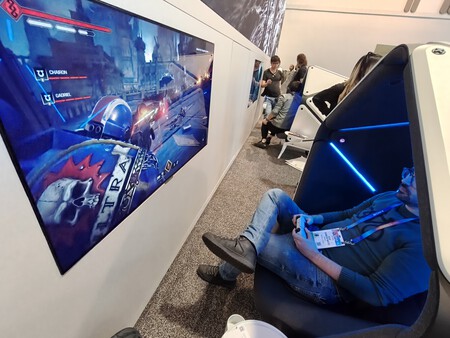Strolling the halls of CES isn’t just an excellent cardio workout—it’s also a chance to discover all sorts of unique products. It’s undoubtedly one of the most fun things to do at the world’s biggest consumer technology show, especially when you come across a custom capsule with 20 speakers that lets you sit, isolate yourself from the world, and play games or watch movies like never before. This capsule is called the XEO POD, and I tried it.
It’s big. I wish I had room for it. The idea behind the XEO POD is to create a personal, one-person immersive audio system in a relatively large space. Think a living room or a room solely dedicated to gaming or watching films. It’s not feasible to move it around easily (though adding wheels might help).

The XEO POD is a capsule with a minimalist, elegant finish made of 20 triangular surfaces. It feels surprisingly sturdy, and when you sit in it, you don’t get the impression that it’s wobbly or unstable—quite the opposite. The seat is surprisingly comfortable and slightly reclined. Personally, the only additions I’d need to spend hours in it would be a leg rest and a side table.
According to the company’s website, you can add the table, but I didn’t see it on the demos at CES.


The interior is amazing. Sitting in the capsule, which is open enough to leave your field of vision unobstructed, I found the interior to be high quality and full of surprises. There’s a speaker on each side, creating a 20-speaker, 15-channel array that makes up a 9.2.4 system. It also features a Windows 11-compatible dynamic lighting system that enhances immersion and adds aesthetics to the capsule.

Other details include a haptic system (which I didn’t get to test), a ventilation system to keep the interior cool, and a knob on the right side to control volume, signal source, vibration, airflow, and seat position. The design lets you manage everything without getting up.

How does it work? The pod connects to your TV, console, VR headset, desktop PC, and other devices via HDMI and USB-C ports. The image is projected onto the TV, while the sound comes from the 20 speakers. This multi-channel system lets you fully immerse yourself in the action, pinpointing where each sound is coming from and distinguishing different elements of the soundscape. Dynaudio did an incredible job: The experience was breathtaking.
I played a round of Warhammer 40,000: Space Marine 2 and was blown away by the sound. Not only could I locate every enemy by listening, but the gunshots, voices, and attacks were so powerful that I couldn’t tear myself away. The environment wasn’t ideal—in the middle of a hall at the Las Vegas Convention Center, surrounded by people taking notes—but I could imagine what it would be like to play a first-person shooter at home on this device.
I also watched a scene from Ready Player One, specifically the racing sequence. The experience was outstanding. In the game, the sound let me know what was happening at all times. In the film, I could feel the cars moving from one side to the other, explosions traveling across the screen, and voices coming from precise locations. That’s 20 speakers working in harmony, and it shows.

Two disadvantages. The XEO POD is spectacular, the kind of product that makes you think, “Wow, if I weren’t broke and had space…” That’s the XEO POD in a nutshell. The experience inside is incredible—one of the best I’ve tried—but it has two drawbacks.
First, the posture. While playing with a controller is extremely comfortable, I can’t see myself using a keyboard and mouse without some sort of table to hold them at the right height and distance. Without it, playing certain games seems impractical.
Second, the price. The device isn’t on the market yet, but the company plans to launch it by the end of 2025. So far, so good—except the price. At $10,000, it’s out of reach for most users. It’s not just about space. It’s also about budget.
This isn’t a product designed for the average gamer but rather a premium luxury device for a select audience. Most of us won’t make the cut. Sadly.
Images | Xataka On
Related | This Is Prinker, a Painless Tattoo Printer That Inks Your Skin in Seconds


